
In a previous review, I asked if the Beretta 92 had outlived its usefulness. I, of course, believe that it has not although some (or many) may disagree with me. Perhaps, we need to clarify what ‘usefulness’ is regarding the Beretta 92 and its variants in both government and civilian forms.
My first day back at the range after major surgery made me realize that I needed to shoot a softer caliber of handgun. I was working with the Kimber Camp Guard 10 again and its many FTF issues. The first time shooting this pistol (pre-surgery) I did so without a shooting glove. However, this time a glove was needed. While the recoil from the 10mm cartridge is stout, but manageable, I knew that shooting my favorite .45 ACP cartridge would also take its toll on the body for a while. Not that I am a wimp, mind you, but I knew that the body was going to have to heal a bit more before I returned to my beloved 1911 in .45 ACP, let alone handle a 10mm Auto pistol. A 9mm pistol was in my future for a while.
Because of my propensity for reviewing firearms, I already have an assortment of 9mm pistols to choose from that range from Ruger, to Glock, to Sproingfield (sic) Armory, to Sig Sauer, to Rock Island Armory (Armscor) and even Smith & Wesson, Beretta, and CZ-USA. A choice should be easy, right? Well, Sparky, not so fast!
My reviews of most of these pistols have been positive and I have even recommended a few (if not all) for carry purposes. The Glock G45 is a top contender for me and it has one thing going for it and going against it…it is a Glock. I prefer a hammer-fired pistol over a striker-fired pistol. Yes, I am old school, I have a preference, and it is personal, and may differ from yours.
I can accept a striker-fired pistol if it has appropriate safety mechanisms in place other than a trigger ‘flapper’ safety, such as a grip safety like the Springfield XD series (except for the XD-E). My other “old school” preference is for handguns to be of metal, preferably stainless-steel but I can also work with carbon steel with protective finishes. I do prefer wood stocks but can accept polymer for a brief period while waiting on the wood stocks to arrive. You can see that I have eliminated a lot of excellent quality handguns by my personal “old school” preferences.
Even with my personal “old school” preferences in place, a lot of desirable hand cannons are left to consider. In the 9mm caliber, there are plenty to choose from. Leaders in the industry, like Sig Sauer, CZ-USA, Beretta, EAA, and even Armscor have firearms from expensive to reasonable in cost that will fit the bill for personal protection. Throwing in for high-capacity (a personal preference for the caliber) in the 9mm dims the likelihood of the Armscor 1911-based 9mm pistol being chosen for carry, one of which I have and it is an excellent shooter.

The CZ-75B, shown above, was a strong contender for top spot, especially in the BD (de-cocker) configuration. Designed in 1975, the CZ 75 is a well-established firearm, my hand wraps around the grip like a glove and the ergonomics of the pistol is excellent. The CZ-75 can be carried in ‘Condition 1” and the 16+1 rounds capacity certainly qualifies as a high-capacity firearm. It was hard to discount the CZ 75 in my final selection, and I decided to have a semi-final between the Beretta M9 and the CZ 75BD. More on that later.
So, I guess that leads us to one of my semi-final personal protection carry solutions – the Beretta M9. But, let me first talk about its predecessor, the Beretta 92.
The series 92 Beretta pistols are semi-automatic firearms functioning on the short barrel recoil principle and using a falling block locking system. Upon firing, the pressure developed by combustion gas recoils the slide-barrel assembly. After a short run of slide-barrel assembly, the locking block falls and releases the slide letting it recoil while the barrel stops against frame. The slide, during its rearward movement, extracts and ejects the fired cartridge case, cocks the hammer, and activates the recoil spring. Pushed by the recoil spring, the slide then moves forward feeding the next cartridge from the magazine into the chamber and causing barrel-slide locking. The slide is designed to stay open after the last cartridge has been fired and ejected. – Source: Beretta.
The original 92 featured a frame mounted safety and a heel magazine safety. This was later updated into the 92S, which transferred the safety to the slide and made it de-cock the pistol when it was engaged. Subsequently, the 92S and the majority subsequent models of the 92 series cannot be carried cocked and locked.
(Author’s Note: When Taurus began manufacturing the Model PT92 and Model PT99, around 1980, the design followed, and still follows, the original design of the Beretta 92, which had the frame-mounted safety/de-cocking lever.)
The 92S saw remarkable success with European law enforcement and militaries, and later evolved into the Beretta 92SB, which was designed for the United States military trials. The 92SB featured an ambidextrous slide mounted safety, three dot sights, and a relocated magazine release from the heel of the grip to behind the trigger guard for faster reloading.
The 92SB then evolved into the 92F, which most notably squared the front trigger guard and was finished with Beretta’s famed Bruniton finish for better corrosion and moisture resistance (previous Beretta pistols had a blued finish, which is significantly less resistant to corrosion and moisture). The 92FS of today is a 92F with an enlarged hammer pin, which was done to reduce the chances of the slide flying off the weapon if it cracks.
Meanwhile, the Beretta M9, the standard sidearm of the United States military since 1985, and sold on the civilian market, is essentially a 92FS with only a few minor changes.
First, as a slight twist to things, let me introduce the reasons not to choose the M9 as a personal defense carry companion. If you are familiar with the Beretta 92/M9, these will be quite evident and quite possibly the reasons why you do not carry one and prefer the Glock (or other pistol) over the M9.
FIVE DISADVANTAGES OF THE M9
- The first disadvantage of the M9 is its size and weight. While it reduces recoil and helps with accuracy (especially with the aid of that fixed barrel), it is still not as light as a Glock 17, one of its primary competitors.
- The Achilles heel of the 92 series of pistols, overall, is the exposed locking blocks. If the locking blocks fail, the entire pistol fails, and that is unavoidable. It is recommended that the locking blocks be replaced every five thousand rounds.
- The M9 has a DA/SA operation, and the DA trigger mode is long and heavy. The SA trigger is much shorter, heavy, and is not exactly crisp. You can help remedy this by installing a lighter trigger spring, but still, the trigger of the Beretta M9 is nowhere close to the triggers of the Walther PPQ or CZ P10C.
- The grip of the M9 is also wide and large in comparison to other handguns, which means it will not be the greatest option for shooters with smaller hands.
- The slide mounted safety/de-cocker is a source of contention for many. If you are used to a 1911 thumb safety, as I am, the transition to a safety like the Beretta M9 can be downright frustrating. However, with some practice the de-cocking and setting the safety to the correct position (off safe for DA carry) will become automatic. A “G” kit; however, can be installed that allows the de-cocking lever to automatically spring back into a ‘ready’ position upon release of the de-cocking lever.
ADVANTAGES OF THE M9
“One man’s trash is another man’s treasure,” or the saying goes. For me, the perceived disadvantage of the Beretta M9 of size and weight is not a disadvantage. My personal preferences are mine alone and may not reflect your personal preferences. I prefer large heavier firearms to smaller light firearms and will carry them if I still can. The Beretta M9 certainly fills that preference. While concealing the Beretta M9 is a challenge, it is doable, at least for me. I will talk about that later. While the M9 is considered “large” for the caliber it shoots, large translates into ease of shooting. Heavy and large translates to less felt recoil as there is more mass and weight to soak up the recoil.
As far as the exposed locking block having to be replaced at so many rounds, I just consider that as a preventive maintenance item around 22,000 rounds, along with recoil spring and hammer spring replacement, and not a disadvantage. The locking block is normally inspected, as a routine check, when the firearm is disassembled for cleaning.
The Beretta M9 is a DA/SA operated pistol. Having run DA/SA pistols in the past I understand the distinct modes of operation between the two. If you have ever fired a double-action revolver in the past, the trigger on the Beretta M9 is comparable in that the trigger stroke is long and 11.7 pounds heavy (average over five pulls). It is, agreeably, not the best double action trigger I have ever pulled, but it is not the worst. When new, the double-action pull is smooth and there is no stacking. However, after some practice, you begin to ‘sense’ where the double-action trigger is about the break. The secret is to maintain a steady pressure on the trigger during the pull, keeping the sight picture intact, and then follow through once the hammer drops.
After the hammer drops, the pistol is now in single-action mode. Release the trigger just a bit and the M9 resets. At this point, you can continue firing the pistol in single-action mode with a 6.0 pound trigger pull (average over 5 pulls) or de-cock the hammer to move into double-action or safe mode. In fact, this is one of my self-training methods; (1) Fire one shot double-action and one shot single-action, (2) De-cock and place safe in “fire” position, (3) Repeat Step 1 and 2 as necessary to become proficient. Then, since the M9 has an ambidextrous safety/de-cocker, perform the same weak handed. A “Mozambique” drill is run with the first shot to CM (Center Mass) being double-action, the second shot to CM in single action and the third cranial shot being single-action. The option to de-cock is open at that point.
I do not consider the DA/SA trigger a disadvantage. It is simply something that is part of the pistol and needs to be trained through. I use the first joint of the trigger finger on the trigger, as I would on a double-action revolver. The trick is to prevent the trigger finger from curling around the trigger, which tends to put lateral pressure on the trigger and a left impact of the bullet on the target is almost guaranteed. The trigger must be pulled straight back. Single-action (SA) operation is a whole lot better than double-action. There is a lot of take-up before the trigger is engaged. However, at that point, the only thing the trigger needs to do is release the hammer, and it does that very nicely and with 6.0 pounds of pressure. The reset is quick and when you learn where the trigger reset point is there is no reason to take the finger off the trigger unless you are no longer planning to shoot.
(Author’s Note: I do not modify triggers on defensive carry handguns. While I may have the action polished, to smooth out the action, which would be indicative of an action after a lot of use, I will not change spring pressures.)
Moving onto the grip size. I can agree that the grip size is large. I can also agree that small-handed folks will have a challenging time holding it due to its largeness. I; however, am not one of those people. I am usually the one adding a Hogue Ruger Finger-Groove Wraparound Grip on it – and have on another Beretta 92FS until I settled on a set of beautiful Beretta wood grips, since the pistol was no longer being shot. In my hand, the Beretta M9 grip is near perfect in width, angle, and trigger reach.
The slide mounted safety/de-cocker is a source of contention for many. If you are used to a 1911 safety, as I am, the transition to a safety like the Beretta M9 can be downright frustrating, since the thumb must move in a different direction from what it is used to. However, with some practice (refer to my previous training exercise) the de-cocking and setting the safety to the correct position (off safe for double-action carry) will become automatic, and your sore thumb from flipping the safety/de-cocking lever back and forth will eventually heal.
Some have complained about the safety/de-cocker moving into the ‘safe’ position when racking the slide to the rear. I have never experienced this with any Beretta 92 product. In fact, I grasp the safety/de-cocking lever when I need to slingshot the slide. If I use the over-hand method, my thumb and trigger finger are pressed against the safety/de-cocking lever to assist me in doing that action.

A “G” kit, shown above, can be installed that allows the de-cocking lever to spring back into a ‘ready’ position upon release of the de-cocking lever. This take a two-step process and removes one of the steps, which simplifies things. I plan to take advantage of installing a “G” kit as soon as I can. Before I do that; however, I needed to learn if the trick to operate the safety/de-cock lever actually works.
I found that if, when the safety/de-cocking lever is in the ‘de-cock’ position, I push down and forward on the lever, it returns to the ‘fire’ position without a problem. It is just a matter of training the thumb to do your bidding. If the safety/de-cocking leer is in the ‘fire’ position, I can push downward on the lever to de-cock the hammer and then push forward an up on the lever to move it to the ‘fire’ position.
IF I do have a complaint regarding the M9 it is with the magazine release. The magazine release is hard to press, and even with my somewhat large hands, I have to shift my grip to press the magazine release.
Moving Forward
Now that some of the advantages vs. disadvantages are out of the way. Let us look at the pistol itself, although I am sure that some of you are already familiar, if not intimately familiar, with the Beretta M9.
In its present form, the Beretta M9 is an excellent service pistol and the model sold commercially is just as excellent. And, the present form of the Beretta M9 is also its final form; the U.S. Military have no upgrades/improvements scheduled. So, what you see is what you get, and any upgrades/improvements will be left up to the owner of this fine pistol.
There is an interesting and eye-appealing contrast between the slide, the barrel, and the frame of the pistol. While the slide is a semi-gloss finish, the barrel and frame are more of a flat finish. I like this contrast. Even the standard polymer grip panels look good on this pistol, although I believe that the Beretta walnut checkered grip panels will look better. The provided grip panels are well checkered, adorned with the Beretta logo, and provides a very good gripping surface, which is aided by front strap and rear strap vertical serrations.
The steel barrel and slide mated to an aluminum receiver was the “thing” in the early eighties to keep weight minimal, and is still a winning combination today, although lighter polymer-framed pistols are now the new “thing.” Also, a modular concept is fast approaching popularity, as changing calibers is as easy as swapping out a trigger group to a new frame and upper assembly. In this sense, the Beretta M9 is an arcane piece of machinery and the Sig Sauer M17 (P320) is the new wave.
The Beretta 92/M9; however, will remain an iconic pistol if the word ‘iconic’ remains in the English language. With its “open-top” slide design, the Beretta 92FS has been immortalized on the big screen in various models and degrees. From the Beretta M1923 came the open slide design, while the alloy frame and locking block barrel, originally from Walther P38, were first used in the M1951. The innovative design led to a lot of people wanting one, and a lot of people have one, which is usually relegated to the gun safe.
One of my personal preferences for a personal carry pistol is that the carry pistol has enough safety mechanisms to make the pistol safe to carry without overdoing things. The M9 features multiple internal safeties, including a firing pin block that prevents the firing pin from moving without the trigger being pulled, and a firing pin striker that rotates when the safety lever is engaged preventing the firing pin from being hit even if the hammer falls. The M9 also has an ambidextrous external safety lever allowing both left and right-handed users to engage or disengage the safety mechanism.
I also mentioned that I like all steel firearms. The Beretta M9; however, does have polymer parts; Starting around the year 2000, Beretta began replacing some parts with polymer and polymer coated metal. Polymer parts include the recoil spring guide rod (which is now also fluted), magazine floor plate, magazine follower and the mainspring cap/lanyard loop. Polymer coated metal parts include the left side safety lever, trigger, and magazine release button. Not enough to be concerned about, really. I will; however, replace the polymer guide rod with a stainless-steel unit at some point.
The Bruniton finish has two main advantages: it is non-reflective, and it is designed to withstand rain, sand, and corrosion as well as stainless steel. It should hold up to leather holster wear quite well, as this pistol will never feel Kydex on its surface.
I like the sights on the M9, shown below, which are a simple one dot up front and one partial dot in the rear; whereas, my Beretta 92FS has the more traditional two rear and one front dot sight arrangement. With the M9, simply line up the front dot to complete the partial dot on the rear, place the combined dots on the target, and maintain that sight picture throughout the trigger pull.
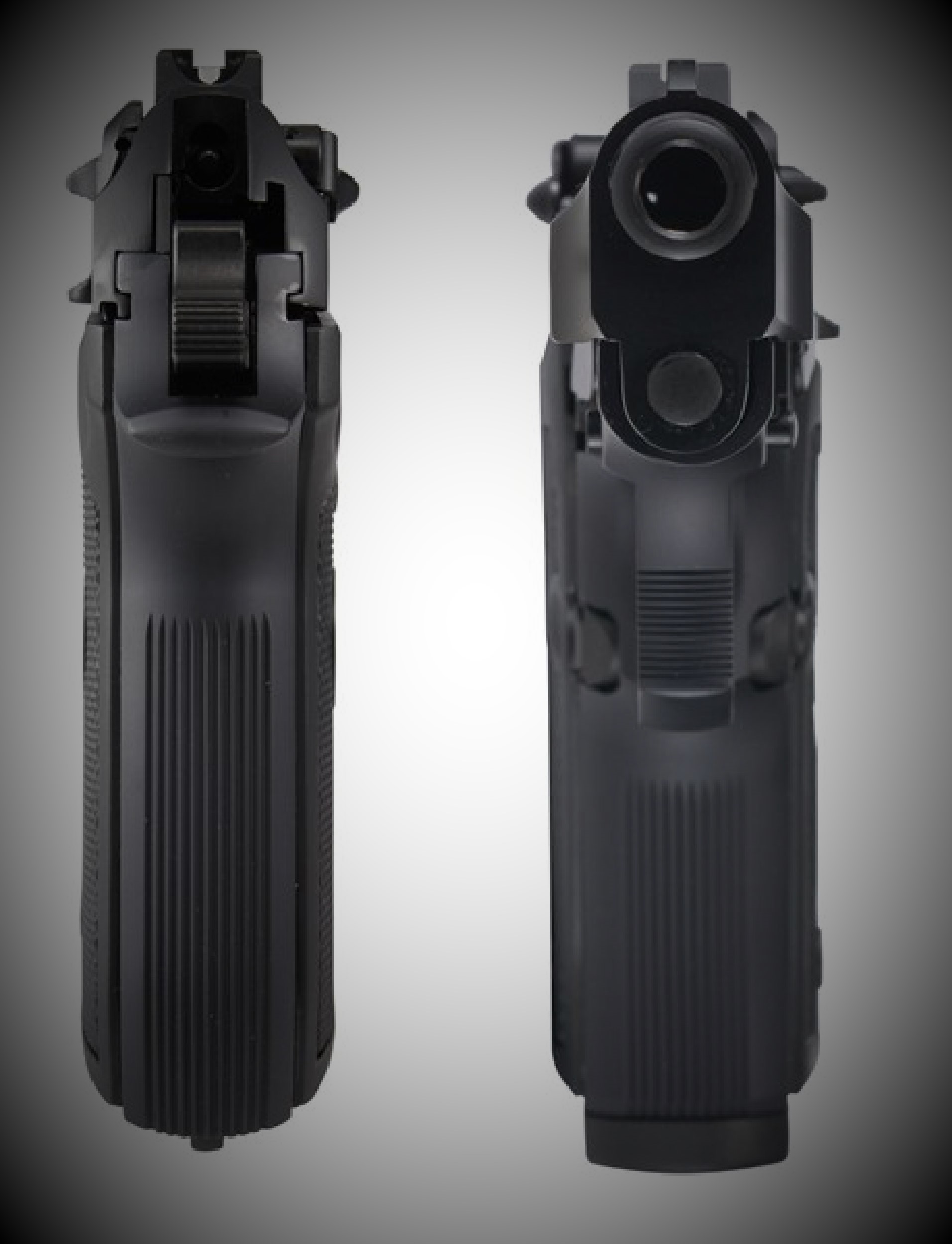
The front sight is part of the slide with no means of adjustment. The rear sight is drift adjustable for windage. The M9 is as ‘combat accurate’ of a pistol that I will ever need.
The Beretta M9 is also well known for its reliability, which is a good thing when using standard 15 or 17 round factory magazines, or with the 15 or 18 round magazines offered from Mec-Gar. The inline barrel also has a lot to do with reliability, as this feature, combined with the added weight, makes the Beretta M9 a perfectly accurate firearm that is surprisingly easy to shoot for its generous size and bulk.
The last point that I want to touch on is the ‘second-strike’ capabilities of the Beretta 92/M9 family. Second-strike simply means that when you pull the trigger, regardless of mode (double-action or single-action) and the cartridge does not fire, simply pull the trigger again. If the cartridge fires, you are good to go. If the cartridge does not fire, then the standard rack the slide to expel the offending cartridge and chamber a fresh round (if one is available) applies.
The cost of the Beretta M9 is within most folk’s monetary comfort level. While it boasts the same features as the Beretta 92FS, the cost is close to several hundred dollars less. But does less cost translate to less performance? Let’s go to the range and find out.
Range Activity
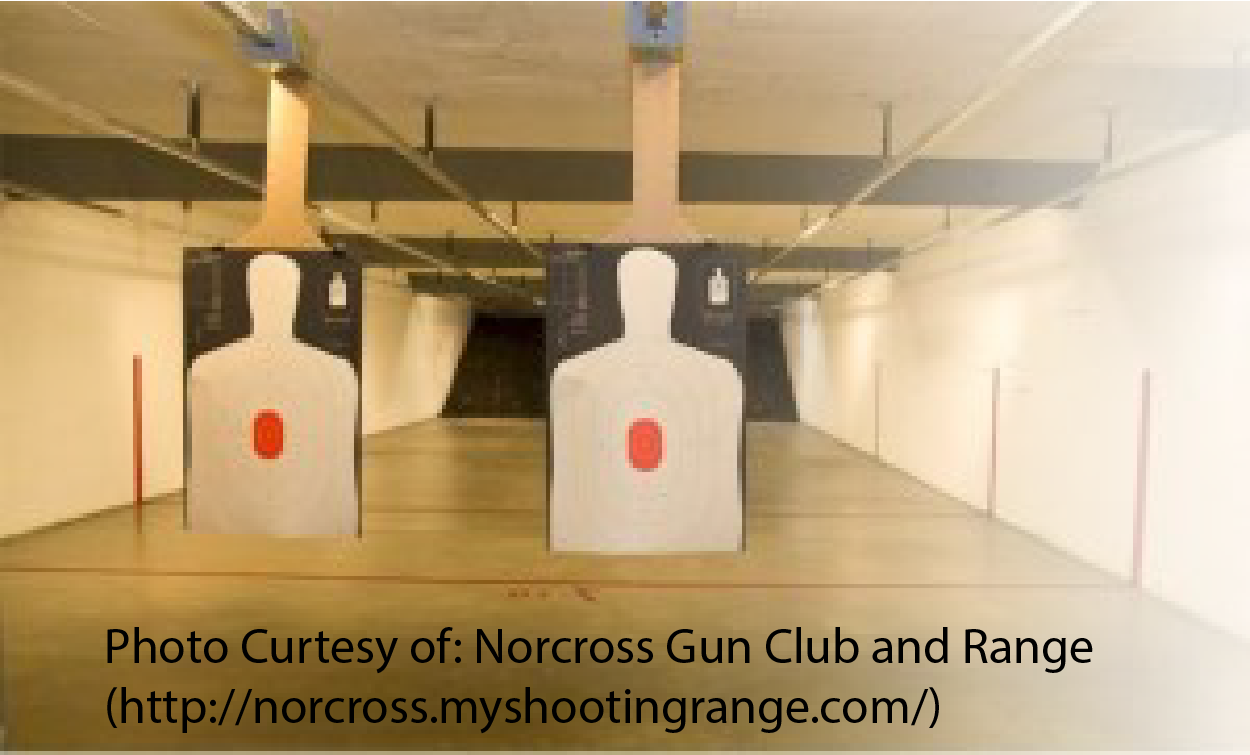
While I enjoy writing gun and gear reviews, shooting the firearms that I review is always something that I look forward to.
Like a few of the firearms I have reviewed, the M9 will make many range trips with me, but I need to confine this review to a single effort for my “test” trip. Fortunately, I have also introduced several shooters to my new M9 and can share some of their feedback as well. One friend is a die-hard Glock fan and the other is a 1911 guy.
The first notable characteristic that comes in to play when shooting the M9 is its overall heft. The pistol is by no means light and anyone looking to holster it for carry will want to make sure their belt fits very well. However, on the range, this bulk can be a blessing. Muzzle rise with the M9 is very manageable due to its locked breech operation and weight.
From an accuracy standpoint, the pistol is more than acceptable. I cannot say if the M9 is any more accurate than the average pistol, but in capable hands, it can be a highly effective sidearm. You may remember I previously complained about the trigger. I still am no fan of the trigger; however, a distinction must be made between precision and accuracy. The M9 is a perfectly accurate pistol that I just happen not to shoot as proficiently as I desire – yet. This is more about the shooter than of the pistol. As my new carry for a while, it will be shot on a weekly basis until I am satisfied with my performance using it.
With almost boring results, the Beretta M9 fed everything I put through it. While not an exhausting list, because I was only firing MagTech 124-grain FMJ (1109 fps), PMC Bronze 115-grain FMJ (1090 fps), and also ran some Sig Sauer V-Crown 147-grain FMJ (985 fps) and Sig Sauer V-Crown 124-grain JHP (1165 fps) for defensive load testing, these were enough to tell me that I need not worry about the pistol’s performance, but more my performance with the pistol. While the Sig Sauer V-Crown 124-grain JHP (1165 fps) and 147-grain FMJ (985 fps) performed well out of the M9 (excellent accuracy with low felt recoil), I will still research some other defense loadings that will not batter my budget, the pistol, or me.
I would like to reiterate how much I like the sights on this pistol. They are remarkably similar in nature to the ‘dot-the-I’ sights that I have used and enjoyed in the past. A simple two dot arrangement. Place the front dot on top of the rear dot to complete the rear dot, keep the two aligned during the trigger pull, and you will hit what you are aiming at when the hammer falls.
CONCEALABILITY
Now we can get into the discussion as to how this beast of a pistol can be concealed. Now, I am sure that I am not the only one who is carrying a Beretta 92/M9 concealed. With that in mind, I am going to tell you what works for me, which may differ with what works for you.
Fully loaded to a 15+1 capacity with 124-grain FMJ ammunition, the M9 weighs in at 2 pounds 7.8 ounces, as compared to a Glock G17 at 2 pounds 0.28 ounces fully loaded with 17 rounds of 124-grain ammunition. As another contrast, the Rock Island Armory Tactical FS 1911, which is my normal EDC, weighs in at 2 pounds 12.2 ounces fully loaded with 7+1 rounds of .230-grains of .45 ACP ammunition.
Granted that the M9 is a sizable and weighty beast and some, due to having fast metabolisms, or are otherwise small or are thin by nature cannot effectively conceal the M9, although I am sure that some can. For the rest of us who are, well, portly or of substantial height, weight, and girth, the M9 can be concealed effectively with the correct combination of holster, clothing, and position on the body.
I would not consider the M9 as an appendix carry firearm, although I have no doubt that there are those that can use this method to conceal the M9. My personal preference for carry is off the right hip or in a shoulder-holster, with the latter being the preferred carry during cold weather with heavy clothing that would not be taken off in a public setting, unless another covering is used to conceal the holster/pistol unit. The latter is also the preferred method when traveling, although my travel these days are restricted to intra-state and adjacent states that allow concealed carry and recognize my Georgia license to do so. Otherwise, I follow state requirements for transportation of firearms, much to my dislike.
As is known among firearms folks, the butt of the pistol is the hardest to conceal, and the Beretta M9 has a lot of butt to conceal. An IWB holster is usually not considered because of the bulk of the pistol. However, an IWB holster should be considered as it is the best means to conceal a bulky frame pistol like the M9. The reason is that an IWB holster, with good belt tension, tucks the pistol into the side better than an OWB holster. Additionally, the ride height and cant of the holster must be considered to present the smallest profile possible.
The chosen hip holster for me is one that I have relied on to house several pistols, a Hawk A112 holster (shown below without sweat shield) from Falco Holsters. The Falco A112 Hawk holster has a reinforced mouth to prevent the mouth of the holster from collapsing when the pistol is drawn from the holster. The attachment system, which consist of two metal clips, keeps the holster well in position. The Falco A112 Hawk is one of the most stable IWB holsters that I have encountered, is of excellent quality, and the cost is well worth the price of admission.
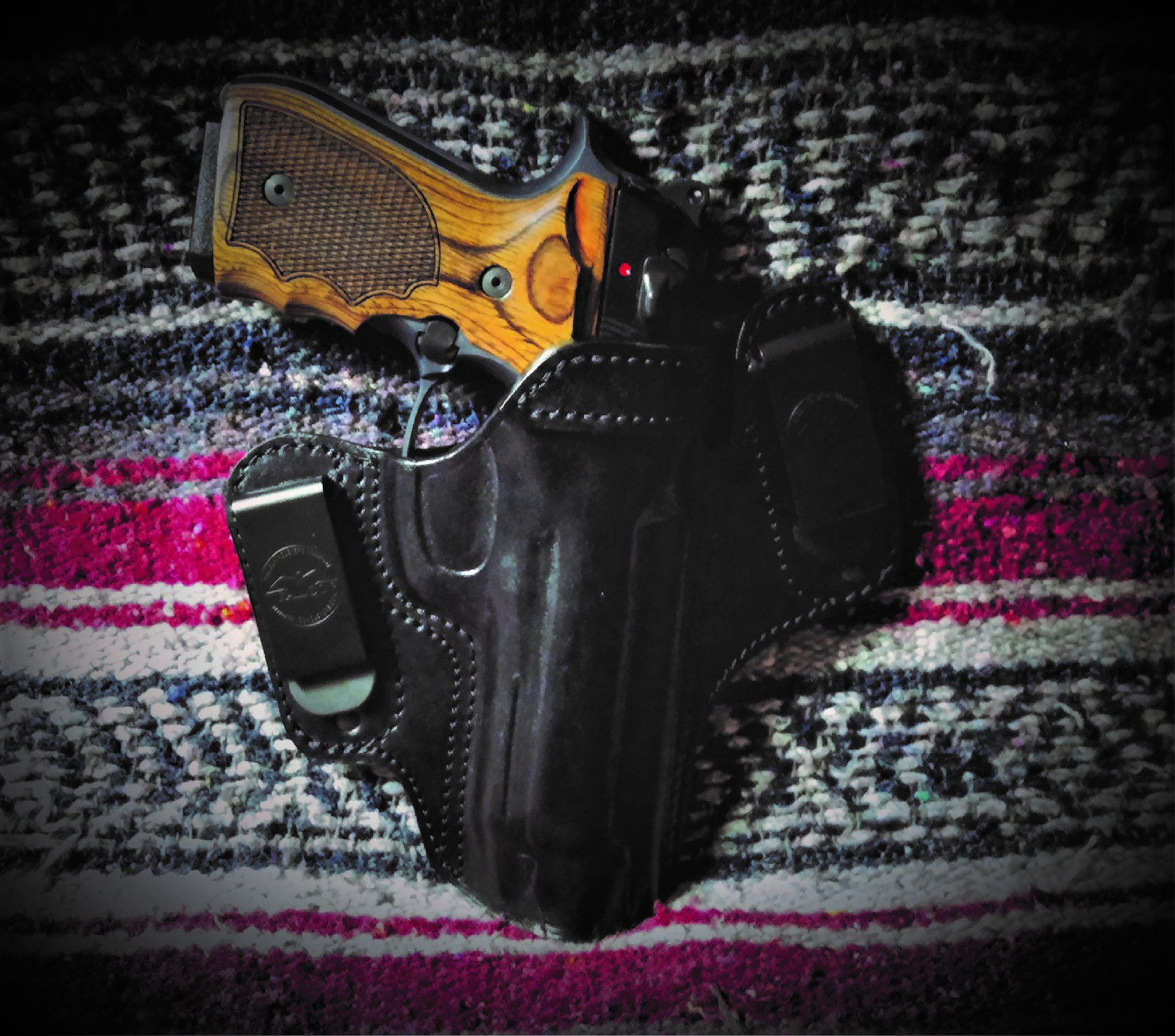
A secondary IWB holster that I like, and only because I consider it as a minimalist holster is the VERSACARRY “Comfort” Holster. The reason that I like this holster (shown below with a Glock pistol), although it can collapse after the pistol is drawn, is that it is the closest thing to not having a holster. Due to the bulk of the Beretta M9, whatever it is carried in for IWB must take up the less real estate and present as low a profile as possible. If I need to go deep cover, I can simply remove the padded protective back, which is attached with industrial grade Velcro and is machine washable for easy cleaning. With only an undergarment between me and the pistol, the VERSACARRY comfort holster provides the best undercover hide that I know of short of “Mexican Carry.”

Another IWB favorite of mine is the “Cumberland” holster from Simply Rugged Holsters, shown below.
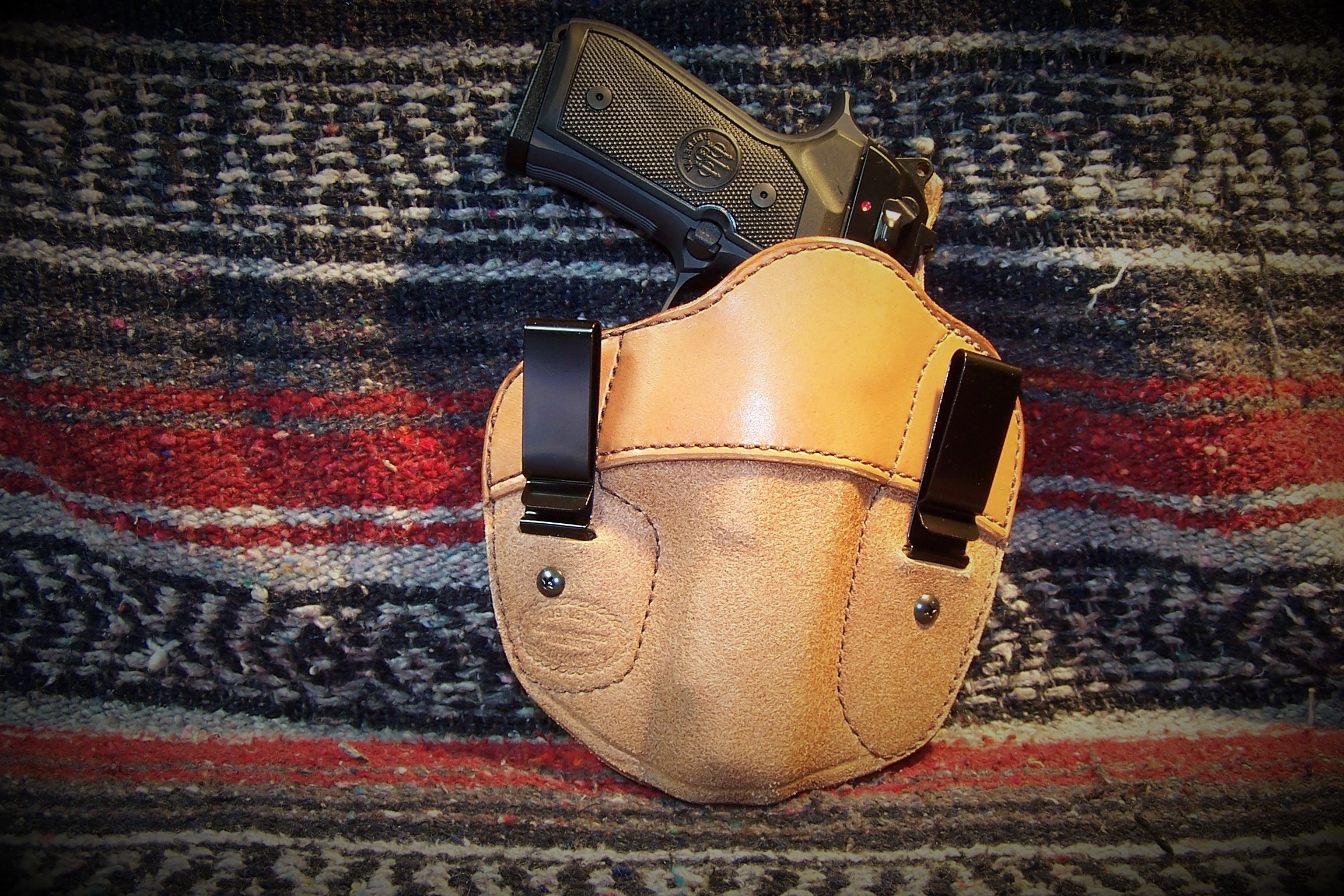
(Author’s Note: A Simply Rugged “Cuda” holster, not shown, is also available for the Beretta 92 series.)
For those who like Hybrid holsters, there is the Alien Gear Cloak Tuck 3.5 IWB Holster (Inside the Waistband) shown below.
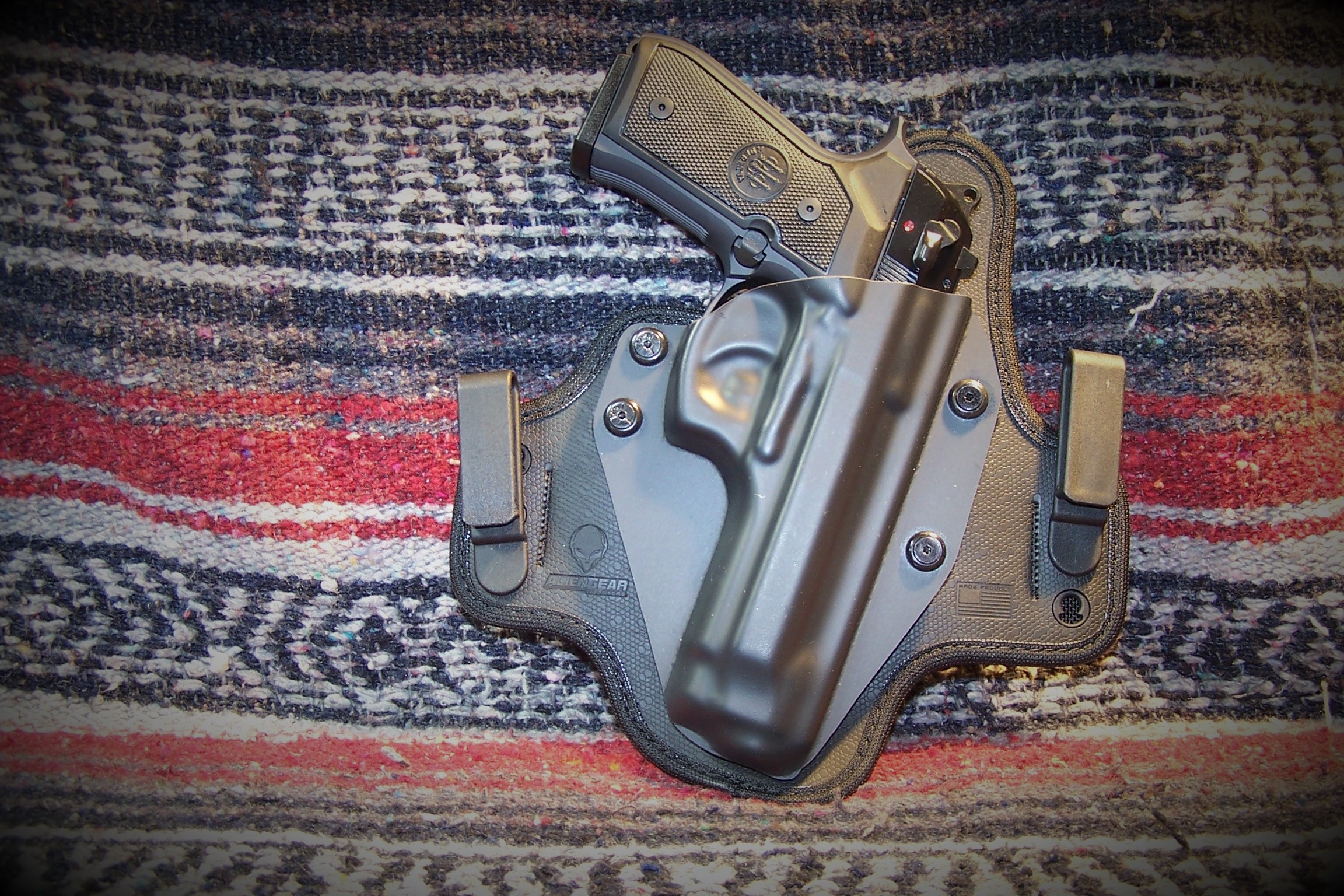
For a shoulder holster, I chose the excellent; albeit, expensive MIAMI CLASSIC II SHOULDER SYSTEM (shown below).
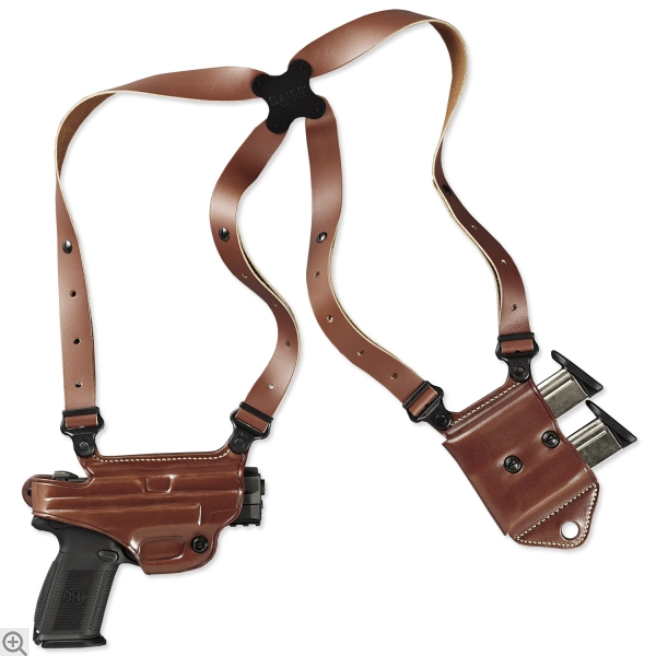
Another alternative in shoulder holsters is the VSH Shoulder Holster System by Galco (example shown below) that positions the muzzle of the pistol down rather than to the rear. It is; however, much slower to draw the pistol.

UPGRADES
The Beretta M9 has been a solid service pistol for the military and law enforcement agencies throughout the world, but as civilian owners we get to play with them a bit.
My first upgrade was the grip panels. I opted to go with the original Beretta grip panels, shown below, rather than experiment with G10 and other grips, which include my favorite Hogue Rubber Finger-Groove Wraparound grips. The original Beretta wood grip panels are a tad thicker than the polymer ones that came with the pistol, which results in a tad thicker grip, but the grip feels good in my hands, the grip panels are very pleasing to the eye, have enough checkering to provide a good gripping surface, and that is all that matters. The Walnut grip panels looked great against the finish of the pistol and add somewhat of a warmth to an otherwise cold looking pistol with its utilitarian plastic grips, although the utilitarian part still applies.

However, these grip panels were eventually replaced with a set of wrap-a-round finger groove grip panels from the Altamont Company (shown below), which fit perfect in my hand, achieve a more desirable grip, and are highly functional.
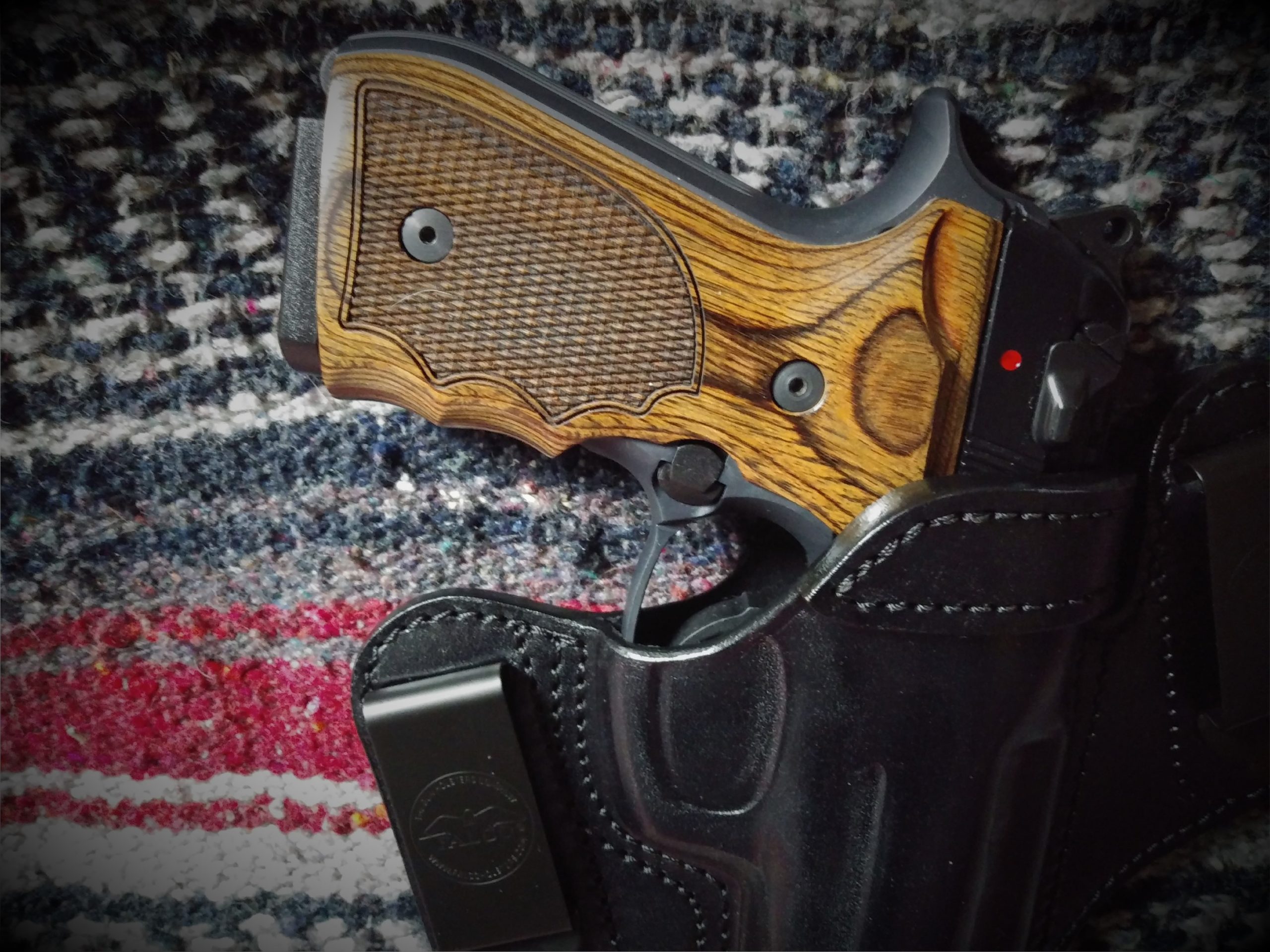
The second upgrade will (maybe) take place in the near future, and that is the installation of the “G” kit (shown below); a kit that when properly installed will convert the safety/de-cocking lever into a spring-loaded de-cocker only; the safety is automatically taken off safe for double-action carry rather than the operator manually pushing it to the ‘fire’ position.
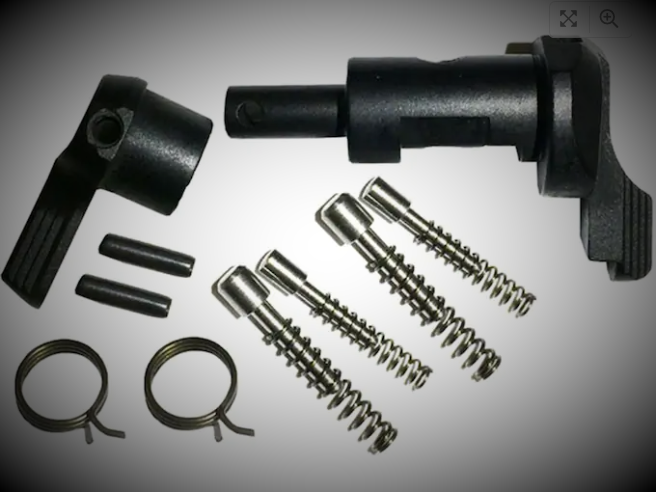
The third upgrade will take place when it is time to replace the recoil spring. This upgrade consists of replacing the polymer recoil spring guide rod with a stainless-steel unit like that shown below.
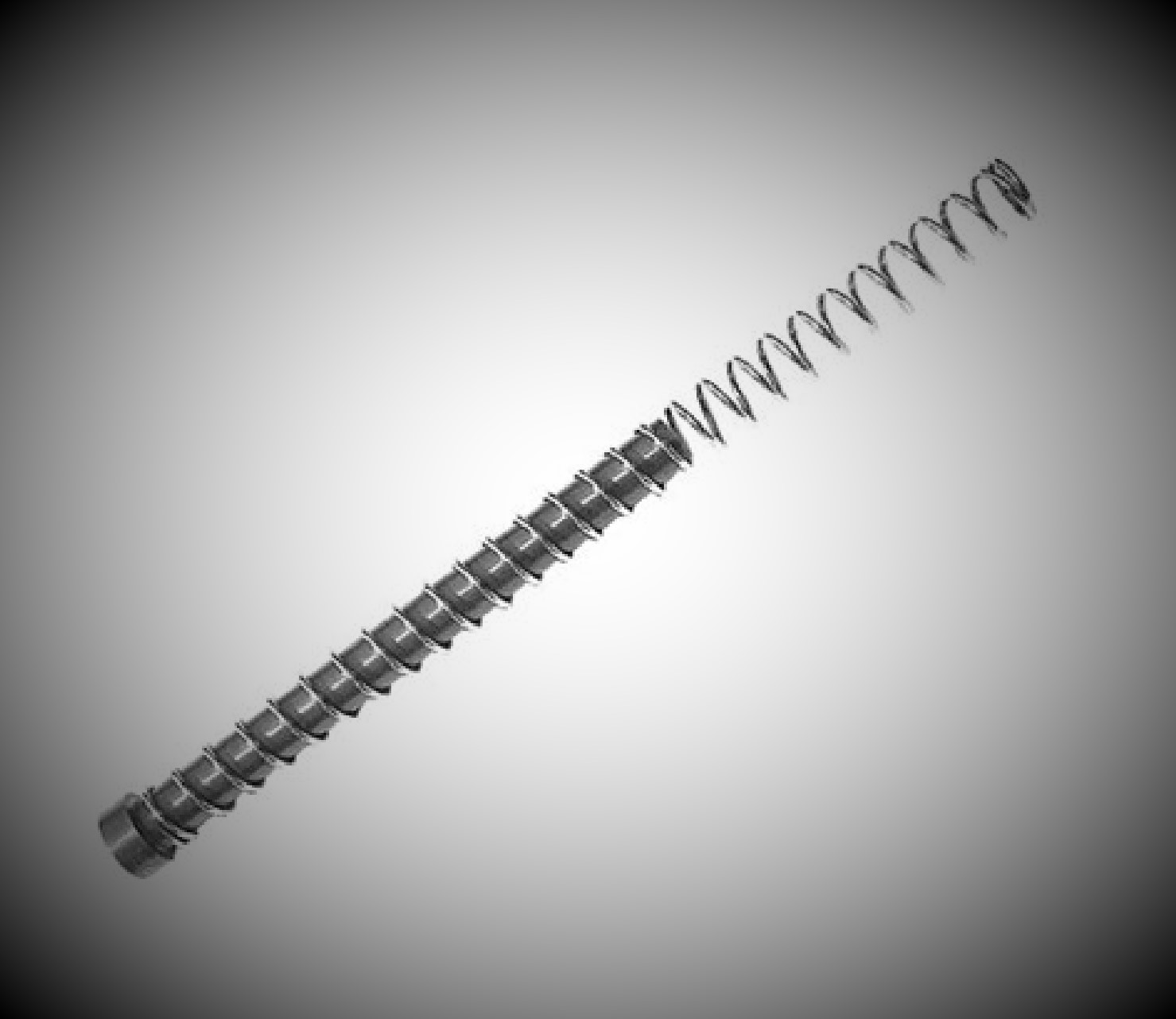
A final upgrade is with magazines. Mec-Gar offers an 18-round, flush fit magazine for the Beretta 92FS/M9 in lieu of the stock 15-round magazines and two were ordered for evaluation. They are indeed flush fit, they do hold 18 rounds, and they work perfectly. I plan on ordering more to increase both my in-pistol and spare magazine carry capacity. I ordered from Midway USA, as they were on sale.
SUMMARIZING THINGS
I must admit that the Beretta M9 was not my first choice for personal protection. The Beretta 92FS INOX was my first choice due to its stainless-steel barrel and slide. Eventually, the INOX version will find a home here, as I like stainless-steel. The Beretta 92FS Compact and a Brigadier may find their way here, as well (if the pistol gods are looking down on me). I do like the Beretta 92 series and my first Beretta 92FS is now a safe queen that I hope to pass down someday.
While large, Beretta pistols fit me personally and the M9 is no exception. I find it a pleasure to shoot and a challenge to conceal. The more time that I spend with it, the more proficient I will become with it.
I am going to go as far as to label the Beretta M9 a “Universal Pistol.” The Beretta M9 can fill many rolls such as a home protector, range gun, or a competition pistol. In rare cases, the M9 may be a hunting firearm or a dispatcher of small to medium four-legged furry creatures that would like to eat your lunch. Of course, it is not the only pistol that can fill these rolls, but it works for me and my purpose for it, which is personal protection. From holster to bedside table, I know that I can rely on it.
In a world of modern pistols with excellent night sights and rails to hang stuff on, the Beretta M9 is definitely ‘old school.’ In my world, I have no need for rails, but I do have a need for excellent sights and the simple two-dot system just works for me.
As I mentioned earlier, the Beretta M9 fits the role of a PDA (Personal Defense Assistant) that combines high quality for the price of a budget pistol. This one will fill in the blank until I can regain my health to challenge larger caliber pistols, especially my beloved 1911 pistols. Even if that does not happen, I am secure in the knowledge that the Beretta M9 will fulfill the duty I have assigned to it. And you never know, the Beretta M9 may become a life-long companion.
I am excited about carrying the Beretta M9. The only thing that could excite me more is to carry the venerable CZ 75 in the omega de-cocker configuration. Hmmm, that is something to think about!
On a final note, and in case you did not know, and although home base for Beretta is Brescia, Italy, the Beretta M9 is manufactured in the United States at the Beretta plant in Gallatin, Tennessee.
Less Expensive Alternative
The Beretta M9, with an MSRP of $650.00 may be too much for your budget. Having owned a Taurus PT92 and PT99 in the past, I can attest to the quality of these pistols. Today, the Taurus PT92 is offered at an MSRP of $533.00, can be found for around $415 to $460 (for the blued model and depending on the source), and which includes a rail and a frame mounted safety. The Taurus PT92 is a less expensive alternative to the Beretta 92FS and M9, and if you prefer a rail. For my money; however, the Beretta is my first choice.
RESOURCES
- Beretta M9: http://www.beretta.com/en-us/m9/
- Beretta G Conversion Kit Beretta 92FS, 96FS: https://www.midwayusa.com/product/1019282643?pid=206052
- Beretta Grips Beretta 92, 96 with Oval Checkering Walnut: https://www.midwayusa.com/product/1004212497?pid=894490
- The Beretta M9 is Strong Even in Retirement: https://www.youtube.com/watch?v=p7e1ftIqnMg
- Beretta M9: The US Military’s Sidearm: https://www.youtube.com/watch?v=k5gwxfeKwmE
- Beretta M9 Unboxing & First Shots: https://www.youtube.com/watch?v=DMlLBzQJrl8
- Beretta 92F or M9 9mm Service Pistol: https://www.youtube.com/watch?v=MWZq2E8MXw8
- The Good, the Bad and the Ugly: https://www.youtube.com/watch?v=uvXva8IFaqw
- 1911 vs M9 Did the Military Get It Right in 1985?: https://www.youtube.com/watch?v=8sCsXCZl9zA
- Shooter’s Corner: Disassembly and Maintenance of the M9: https://www.youtube.com/watch?v=JUW4DTOHYF8
- Beretta M9 Takedown, Clean and Reassemble: https://www.youtube.com/watch?v=h_aQwV76n7Q
- Beretta M92 / M9 Instructional Video: https://www.youtube.com/watch?v=8VP2OyedxDI
- Beretta M9 (92FS) 9mm Semi-Automatic Pistol. Loading and Unloading: https://www.youtube.com/watch?v=DMv-FaY6PK4
- Beretta 92FS – Easy G Conversion Lever (decocker only): https://www.youtube.com/watch?v=hw21jjWZHZo
- Overcoming the Beretta Slide Mount Safety Issue: https://www.youtube.com/watch?v=YExmUVvOqd8
- Beretta M9 (After 10,000 rounds): https://www.youtube.com/watch?v=cgMRaKT3bE4
- Beretta M9 25th Anniversary Edition Range Review – FateofDestinee: https://www.youtube.com/watch?v=RUwmqzqk1hc
![]()

